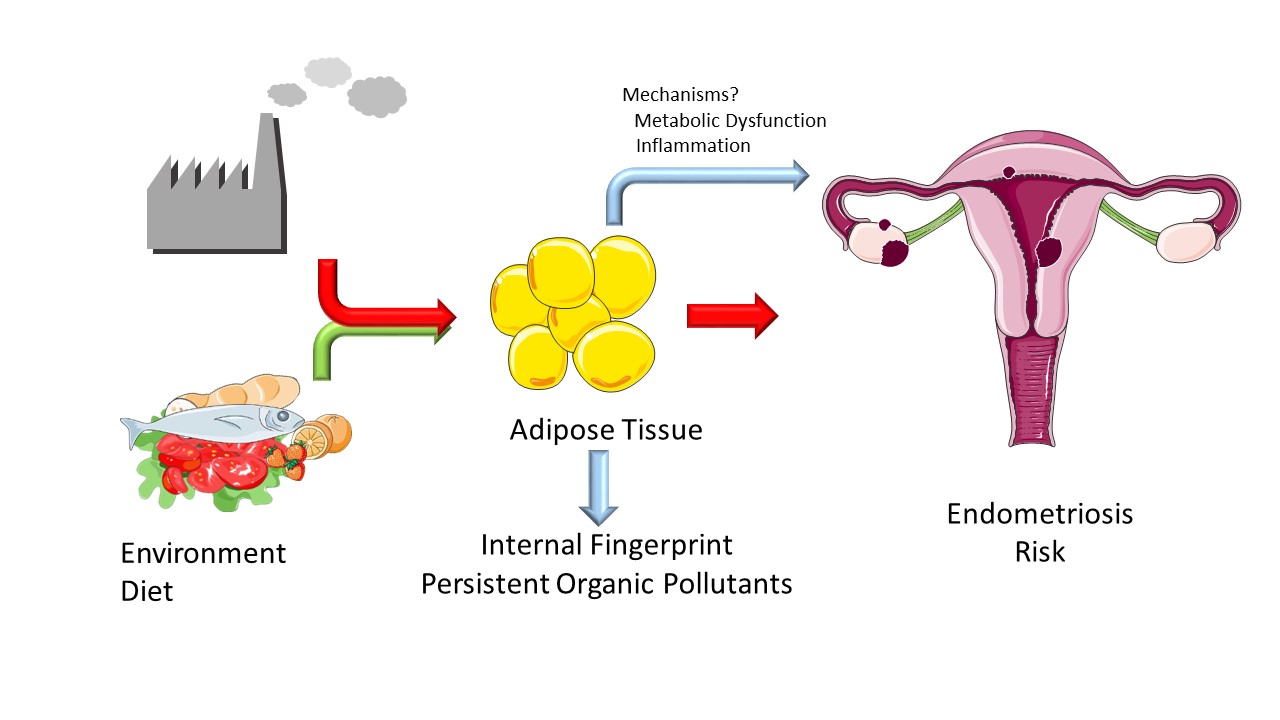Food, Global Health Reading time 5 min
An innovative approach to explore the link between exposure to chemical pollutants and the risk of endometriosis
Published on 20 January 2022

Is endometriosis, a disease with as yet little known causes, favoured by exposure to chemical pollutants?
Endometriosis is a disease that causes severe pain and infertility in women. Between 1 and 2 out of 10 women of childbearing age are affected by the disease, i.e. 2 to 4 million women in France alone. The disease is also problematic for doctors because symptoms are not specific, delaying diagnosis for several years and thus leading also to significant economic and societal costs. The determinants of endometriosis are not well understood, but a growing number of studies has found associations between persistent organic pollutants (POPs) and the progression of endometriosis. POPs were used extensively during the 1960s and 1970s, but banned or strictly regulated because of their toxic properties. Indeed, due to their stable and lipophilic character (affinity for fat), these pollutants are still present in most living organisms after several decades of being banned.

Conceptual diagram of the EndoxOmics-β project -Servier Medical Art (smart.servier.com).
An innovative approach to analyse the ‘cocktail’ effect of chemical pollutants on the risk of endometriosis
As part of a collaboration between the UMR-LABERCA (INRAE-Oniris), the Nantes University Hospital and the Stat-SC Unit (ONIRIS-INRAE), an innovative approach has been proposed to overcome the challenges of the 'cocktail' effect of chemical pollutants. In order to gain insight on the functional links between endometriosis and chemical pollutants, a combination of approaches based on high-throughput mass spectrometry analytical platforms and advanced statistical methods has been proposed.
The main goals of this new approach are to:
- Study the associations between exposure to low-dose mixtures of POPs and the risk of endometriosis.
- Explore the presence of endogenous biomarkers that may help to better understand the mechanisms of these associations between POPs and endometriosis.
The pilot study was conducted on a group of young women with or without endometriosis recruited by the Gynaecology-Obstetrics Department of the Nantes University Hospital. The expertise and analytical capacity of the UMR LABERCA enabled the comprehensive quantification of POPs and metabolic markers present in the women's blood. The advanced statistical methods developed by the LABERCA and Stat-SC units enabled the integration and analysis of these complex data.
Links between the presence of mixtures of persistent organic pollutants (POPS) and the risk of endometriosis
The results of this pilot project showed links between exposure to mixtures of POPs and the risk of endometriosis, particularly with organochlorinated pesticides and polychlorinated biphenyls. The integrative analyses revealed functional links of these POPs with metabolic and inflammatory biomarkers for the first time in women, supporting the findings previously observed in experimental models.
Continuation of the research with an innovative large-scale study over the next 3 years
These results are a first proof-of-concept regarding the methodological feasibility of this new integrative approach, but also supporting the exploratory potential in understanding the mechanisms involved in the development of endometriosis. These results also justify the continuation of this study in a broader population setting, which will be conducted over the next 3 years in a national partnership with the ‘Exposome, Inheritance, Cancer, and Health' Team of the Centre for Research in Epidemiology and Population Health (CESP/Inserm U1018, Villejuif) and the ToxAlim Unit (INRAE, Toulouse), and funded by the French Medical Research Foundation (‘Fondation pour la Recherche Médicale’). This study will be the largest prospective study conducted in a group of women from the general population on the associations between POPs and endometriosis, considering simultaneously POPs mixtures and endogenous biomarkers. The expected results may help to understand the role of exposure to POPs mixtures in the progression of the disease, contributing to develop preventive strategies but also new non-invasive diagnostic tools.
Partners: Nantes University Hospital and the Stat-SC unit (ONIRIS-INRAE)
Funding: Pays de la Loire Region, "Etoiles Montantes" grant 2019
Publication: Matta K, Lefebvre T, Vigneau E, Cariou V, Marchand P, Guitton Y, Royer AL, Ploteau S, Le Bizec B, Antignac JP, Cano-Sancho G. Associations between persistent organic pollutants and endometriosis: A multiblock approach integrating metabolic and cytokine profiling. Environ Int. 2021 Oct 11;158:106926. doi: 10.1016/j.envint.2021.106926. Epub ahead of print. PMID: 34649050. https://doi.org/10.1016/j.envint.2021.106926
